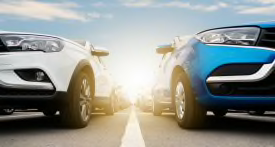Based on the same aging platform as the underwhelming Jeep Compass and the Alfa Romeo Tonale, the new Dodge Hornet R/T small SUV comes standard as an all-wheel-drive, plug-in hybrid electric vehicle (PHEV).
PHEVs operate like a hybrid, but they have a larger battery and can be plugged into a wall outlet or an EV charger. When the battery is fully charged, they can run on mostly electric power (typically for about 20 to 40 miles, depending on the vehicle) until they switch to regular hybrid operation.
The Hornet R/T’s plug-in hybrid powertrain works well for the most part. There’s plenty of acceleration on hand when you need it, and we appreciate the ability to cover a typical daily commute on electric power (provided it’s charged often), along with decent fuel economy when operating as a hybrid.
But the Hornet’s stiff suspension makes for a rough ride, and it isn’t particularly sporty through the twisty bits. In fact, the more we drove it the more we found ourselves wishing for better steering and handling—since it shares components with Alfa Romeo—and wondering why the exhaust note wasn’t the least bit invigorating. Then there’s the loud cabin, and a variety of frustrating controls.
Go easy on the accelerator pedal and the Dodge can cover 32 miles on electric power (according to the EPA) delivered to the rear axle, after which it engages a 1.3-liter turbocharged four-cylinder engine to drive the front wheels. The combined 288 horsepower ensures quick acceleration, with 0 to 60 mph in just 6.3 seconds—that’s quick for the class. When the electric power is depleted, the SUV operates as a conventional hybrid, and achieved an efficient 29 mpg overall. However, the Hornet’s tiny 11-gallon gas tank means that you will have to stop frequently for gas on a long drive.
Although the hybrid system transitions pretty seamlessly back and forth between electric and gas power, there are some oddities to the power delivery. For example, when functioning as a hybrid there can be a big power delay taking off from a stop. Then there’s the way the engine sometimes revs abnormally high while sitting at a stop light—this is the system’s way of keeping the hybrid battery charged to a certain level.
Further, if the Hornet R/T is running on electric power and you step harder on the accelerator pedal while powering through a turn, the gas engine will kick on suddenly if the system determines there isn’t enough EV power to handle your request. This delivers a disconcerting—but not dangerous—burst of power to the front wheels.
Handling is secure, showing strong cornering grip when pushed hard around our track. But in terms of everyday driving (whether on a highway onramp or a curvy road), where steering feedback and response are key for communicating agility and confidence, the Hornet doesn’t stand out and feels rather mundane to drive. What’s worse, we found the ride stiff and choppy. The SUV bounces up and down over bumps like you’re riding a pogo stick—minus the fun. On the bright side, the Hornet exhibited competitively short panic-brake stopping distances.
Although cabin quietness benefits from the ability for the Hornet to run solely on electric power at times, the rear electric motor groans during regenerative braking, and we noted unusually high levels of road and wind noise.
Inside the cabin, our testers found that the limited seat adjustments produced a compromised driving position. Other impediments to getting comfortable behind the wheel included a left footrest that’s too close to the driver which can leave you with tightly bent knees and outstretched arms. At least there are well-placed armrests and decent headroom (note that the optional sunroof makes headroom tight for taller drivers).
We appreciated that the seats themselves came with four-way power lumbar support adjustment, adding to the generally well-shaped cushion and seatback with plenty of lateral support to help hold you in place through corners. Unfortunately, not all body types will fit into this narrow seat, which resulted in many of our drivers looking to bail out of this car after just a two-hour drive. The rear seat has limited headroom, but there’s good knee room and ample foot space under the front seats. But the seat’s flat shape and upright seatback (which can’t be reclined) mean it’s not all that comfortable of a place to spend time.
The controls were a decidedly mixed bag. The infotainment screen is nicely designed, but the icons and text are small, and they can be hard to decipher and press while driving. We noticed that the center screen suffers from noticeable lag, especially when switching between menus—such as jumping between displaying a playlist and the navigation screen. We appreciated that most of the climate controls are physical buttons, but we were annoyed that we had to delve into the center screen to adjust the seat heaters and to sync the temperatures for the driver and front passenger.
We tempered our expectations when it came to the Hornet’s interior finish: By and large, this isn’t a super-expensive car. So, we were pleased to see a few classy details, such as the red stitching on the door and center armrests, and across the mid-dash. But it’s impossible to ignore that the cabin is surrounded by a sea of hard plastics. We also found several exposed mold lines, sharp edges here and there, and indifferent panel gaps.
The Hornet is a pretty narrow SUV, which limits cargo space compared to competing models by a significant margin.
The Hornet comes standard with automatic emergency braking with pedestrian, bicyclist, and motorcycle detection, automatic emergency braking that operates at highway speeds, blind spot warning, rear cross traffic warning, lane departure warning, lane keeping assistance, adaptive cruise control, and automatic high beams.
















